It was always going to be tough to replace Erik ten Hag after the Dutchman headed west to take over at fallen giants Manchester United.
Ten Hag bowed out as a three-time Eredivisie champion, leaving his successor with massive shoes to fill at the Johan Cruijff Arena. CEO Edwin van der Sar and co. opted to offer an old assistant of ten Hag the opportunity to take the reins.
Having won the Belgian Pro League with Club Brugge in spectacular fashion last season, Alfred Schreuder was handed the role of manager with the Dutch giants.
It was always going to be a tough task for the 50-year-old. Ajax had not only lost their manager and his number two, but had also sold more than 13 squad players.
Schreuder’s tenure started reasonably well but petered out like a candle in the rain. By his dismissal at the end of January, Schreuder’s win percentage stood at 46.15 percent, with no victories in his last seven.
Ajax looked inward for a replacement. After working with Jong Ajax for eighteen months, former Netherlands and Everton defender John Heitinga was burdened with the job which he gracefully accepted.
And Heitinga has already steadied the ship, winning seven of his nine games in charge, while placing Ajax back in an unlikely race to defend their league crown.
This tactical analysis piece will be a team scout report of Ajax’s tactics under John Heitinga to observe how the former defender has managed to steady the ship.
Statistically, Ajax are alright
It’s always important to use both the eye test and stats in correlation with one another, but when looking through Ajax’s numbers this season compared to the rest of the league, they’re pretty impressive.
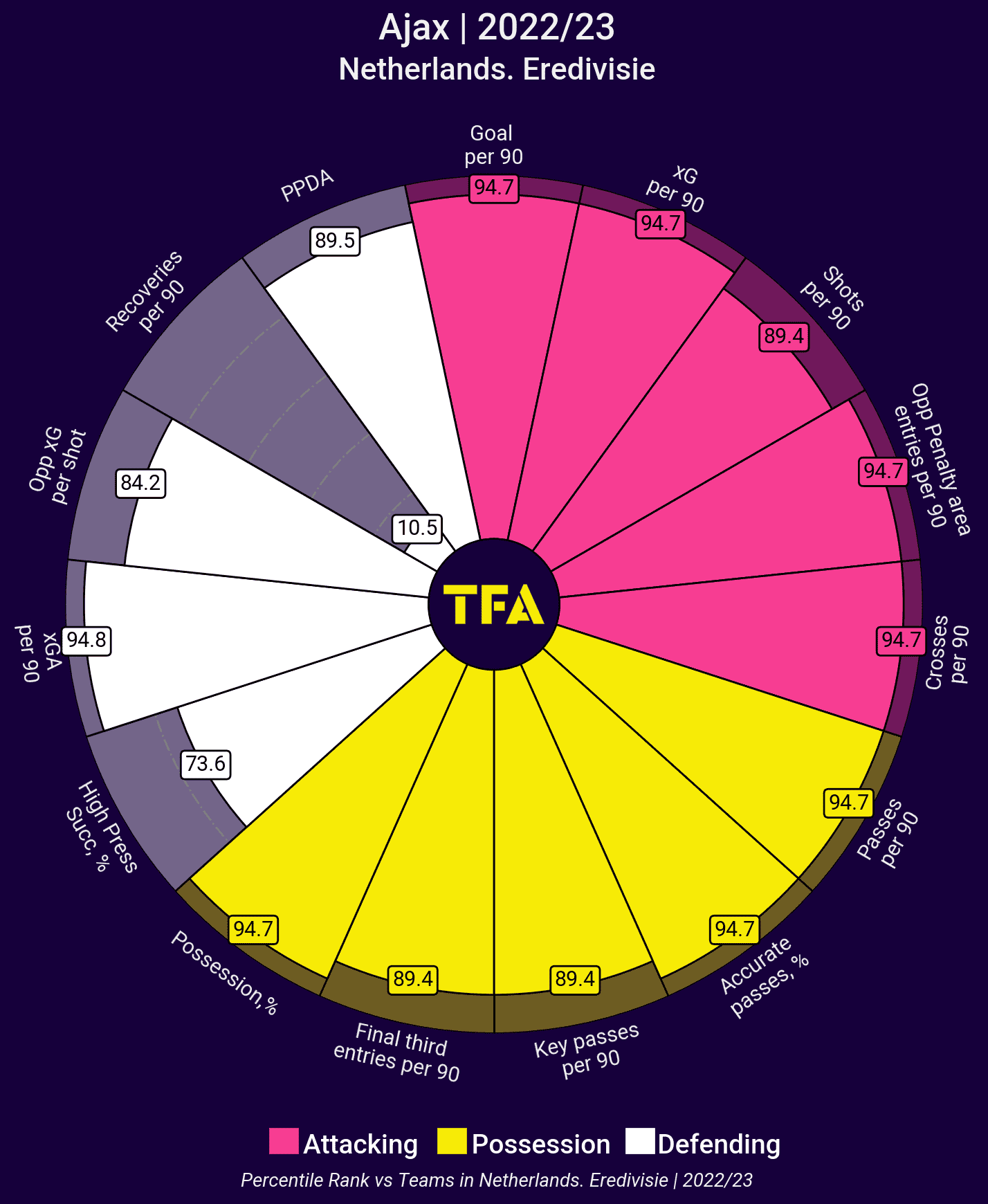
The Sons of the Gods are performing better than the entire league in almost every single metric barring a few. The only statistic that Ajax are falling behind in is recoveries per 90 but this is a direct result of the champions dominating the ball in every game. So, fewer recoveries will happen than any other team because the opposition has the ball less.
Even when Schreuder was in charge, the team played in line with the club’s philosophy of dominating possession of the ball, using plenty of width, creating lots and lots of chances, pressing high, counterpressing and blending youth into the team with experience.
This season, we have seen the rise of Kenneth Taylor who began to start getting blood into the side under ten Hag but has become a regular now under Heitinga.
The new head coach hasn’t changed much regarding formations. Ajax are using a 4-3-3 for the most part. Maybe, in the odd game, the boss will look to use a slightly more balanced 4-2-3-1 but there isn’t a whole lot of difference.

Ajax are not restricted to the confines and limitations of a formation though. Players are given free license to roam around the pitch, keeping in line with the beliefs of football stemming from the late great Rinus Michels and Cruyff himself.
Although, there are restraints to this, like checks and balances that players must be wary of. There still needs to be some sort of positional restriction imposed from the sideline to ensure that the team has balance for when possession is turned over which is exactly what Heitinga has done. But more on this later in the analysis.
Let’s first take a look at how Ajax are playing under the new head coach and see if there is much difference from Schreuder.
A bit more direct
Ajax play out from the back in the same manner as before and even as they did during ten Hag’s reign. The centre-backs split wide of the goalkeeper, with the fullbacks remaining slightly higher but still close enough to receive from the central defenders comfortably.
Meanwhile, the single pivot operates ahead of the backline but behind the opposition’s first line of pressure, screening from left to right and looking to receive to feet.
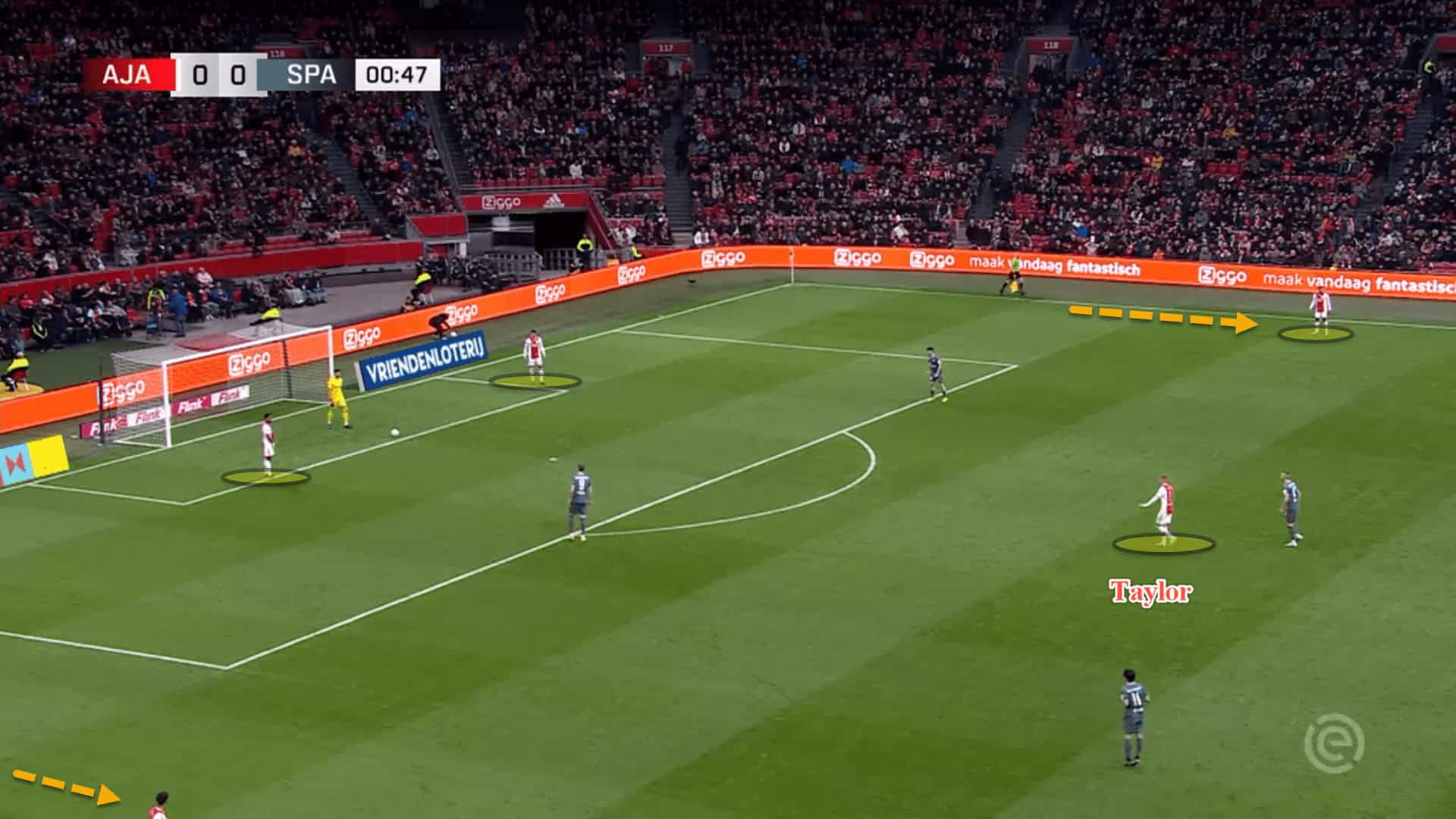
Ajax are patient during this phase. In the previous image, Kenneth Taylor’s reassuring hands are gesturing to his centre-backs to relax after quite a hectic opening minute to the game – such a wise head on young shoulders.
Unlike most teams who want to control where the ball moves by making passes before the opposition closes down spaces, the Dutch giants are fine with being pressed.
This is very on-brand for a new tactical trend of playing out from the back where players put their foot on the ball, waiting to be pressed, before them attempting to up the tempo and play around the pressure.
Roberto De Zerbi’s Brighton are the finest example of this but there are a few teams starting to apply similar methods and Ajax are just another mere disciple under Heitinga.
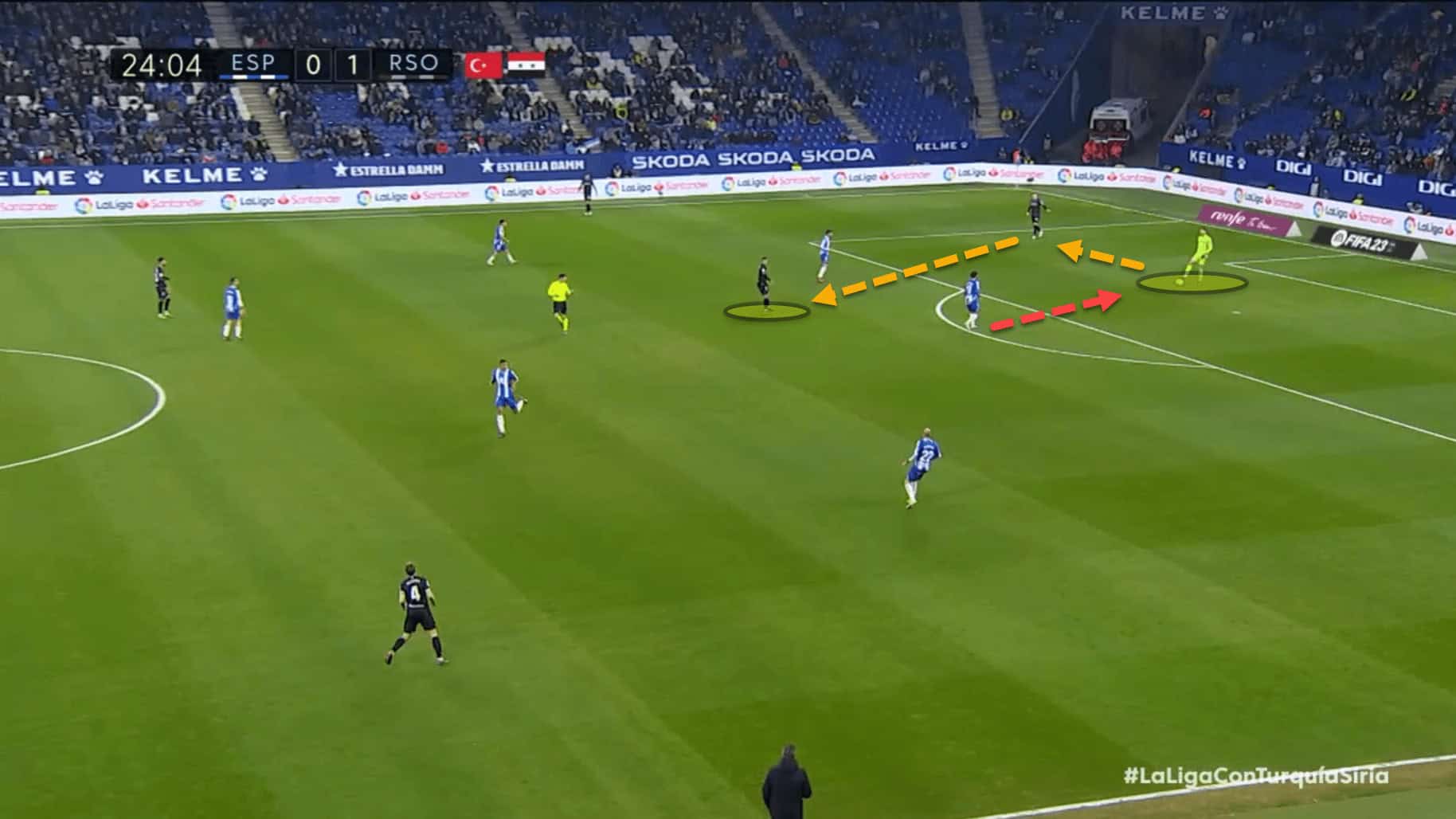
Here is an example of Real Sociedad doing so in a recent game against Espanyol. The first line are waiting and waiting for Espanyol to press, putting their foot on the ball and refusing to make a line-breaking pass until the opposition jumps them.
We see these types of situations from Ajax all the time and it shows real confidence in their ability on the ball and to bait a press.
The primary objective from the build-up phase for Heitinga’s men is to expose the opponent’s backline. What this is means is that, when the opposition are baited to press, Ajax go in behind them with quick passes and a high tempo to reach their attacking players who can then turn and drive forward.
Quite often, this entails going long to the forward line.
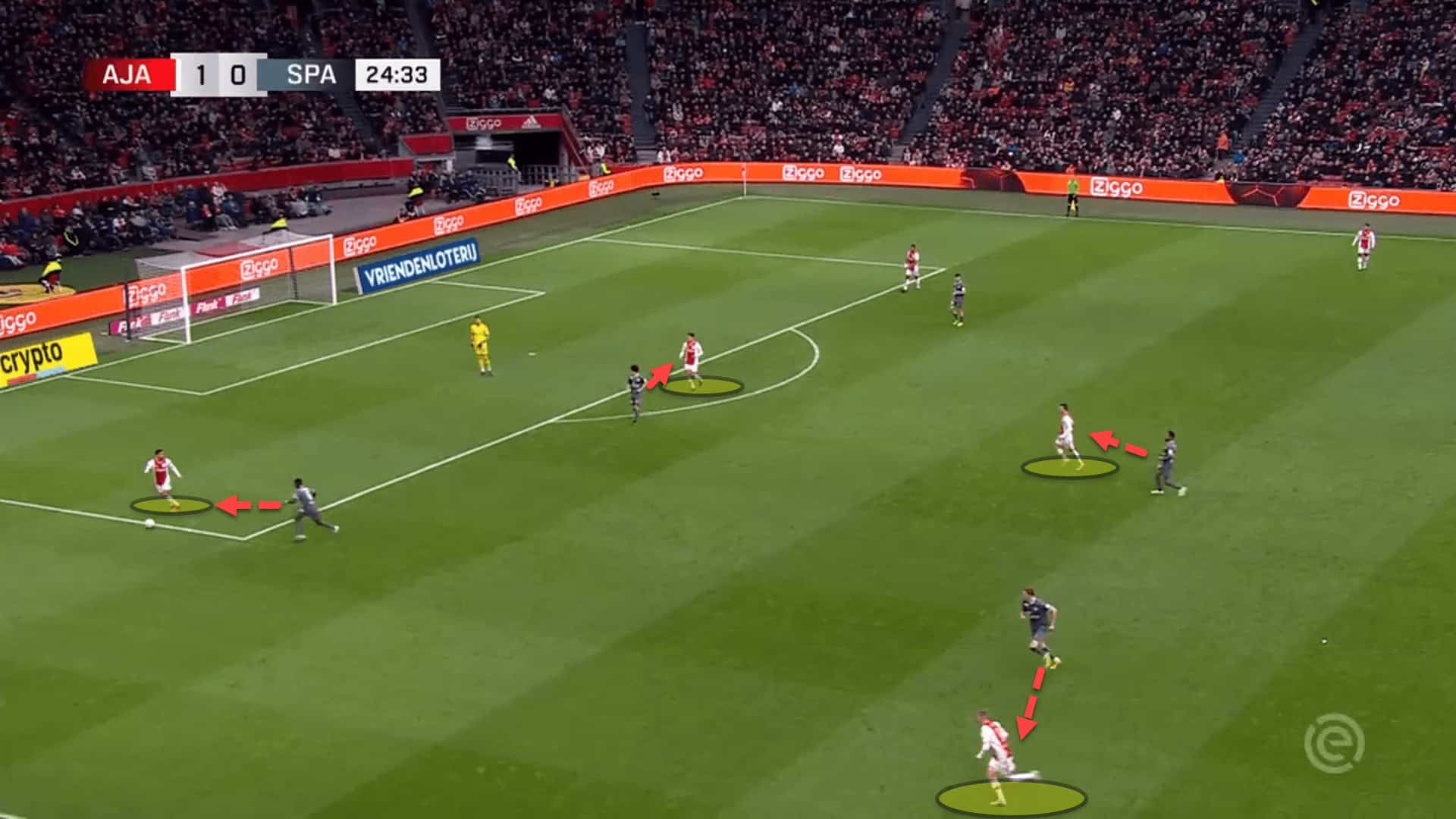
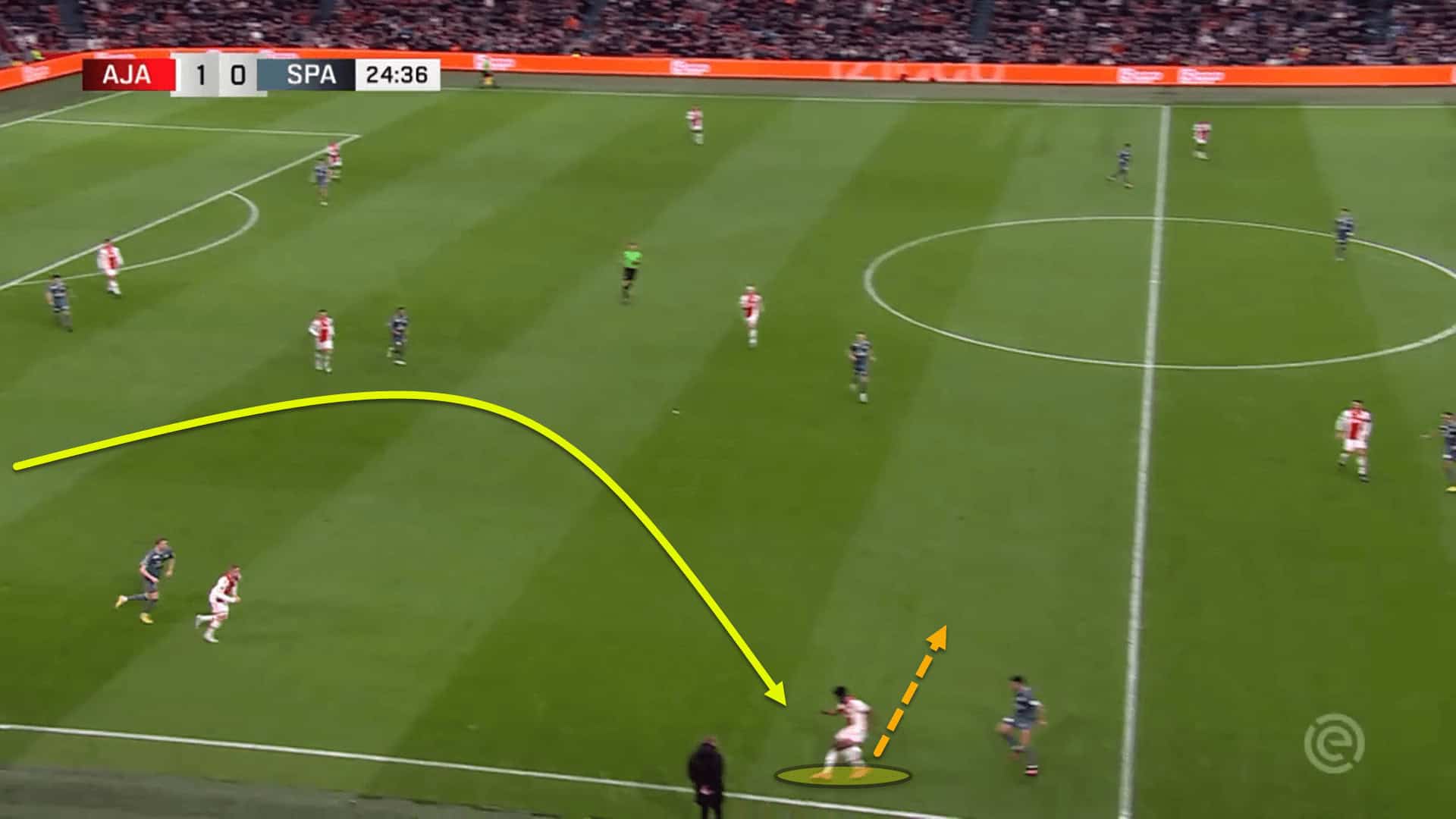
Here, Sparta Rotterdam were pressing Ajax’s attempt at building play from the back. The visitors forced Ajax wide and locked on man-for-man, giving right-back Devyne Rensch no forward passing options on the deck to beat the press.
Instead of turning back and playing to the goalkeeper, Rensch lobbed it directly to the wonderful Mo Kudus in the forward line. The Ghanaian superstar trapped it first-time unbelievably and was able to turn away from his fullback and run at the backline. The chance eventually led to a shot on goal for Ajax.
This is something that was perhaps missing under Schreuder from when ten Hag was in charge. While Ajax were always scintillating during the Manchester United boss’ reign, they could also play direct at times, hence why ten Hag always preferred a target man up top such as Seb Haller or Klaas-Jan Huntelaar.
This ability to play direct completely fizzled out this season, particularly during Schreuder’s reign. Over the course of the campaign, just 7.45 percent of Ajax’s passes have been long, which is just about half their average opponent.
Nevertheless, in recent matches, this has climbed a little. Depending on the opponent, of course, Ajax’s long pass share percentage has seen a rise to 11.01, 8.02 and 9.4 in three of Heitinga’s last seven games and so there is a license to be slightly more direct under the new boss.
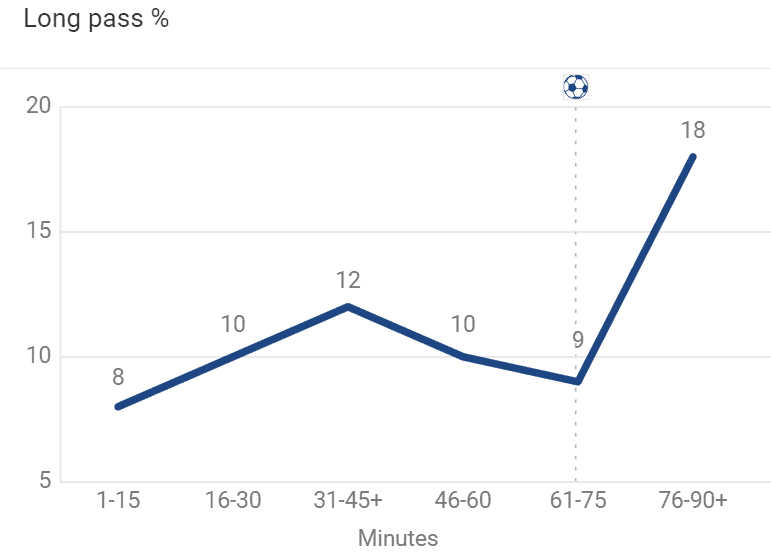
There is a trend that Ajax play particularly more direct towards the back ends of games, especially during cagey affairs such as this 1-0 away victory away at Twente in the KNVB Beker.
But this directness primarily comes from the build-up phase as a means to progressing past the opposition’s press. During settled positional attacks in the other team’s half of the pitch, the style is pretty fluid and constant, requiring immense technical ability as well as patience.
Triple ‘10s’
Under Heitinga, there are quite a lot of positional play principles integrated into the side when Ajax are attacking in the opposition’s half, but the system is far more fluid than we see with Manchester City or Barcelona, two of the most prominent advocates for strict positional play.
In the first line, Heitinga wants his players to create a plus-one scenario to ensure that they always have numerical superiority in this area. Some teams use a back three, a back four or even a back two when passing around the defence but Ajax’s numbers in the first line are a result of the opponent’s set-up.
For instance, if the opposition are defending with two men up top, Ajax will have three players in the first line, asking one of the fullbacks to tuck in or asking the pivot to drop beside the centre-backs to create a 3v2. If the opposition are pressing with merely one player, then this isn’t required and so just the central defenders will do to still have a 2v1 situation.
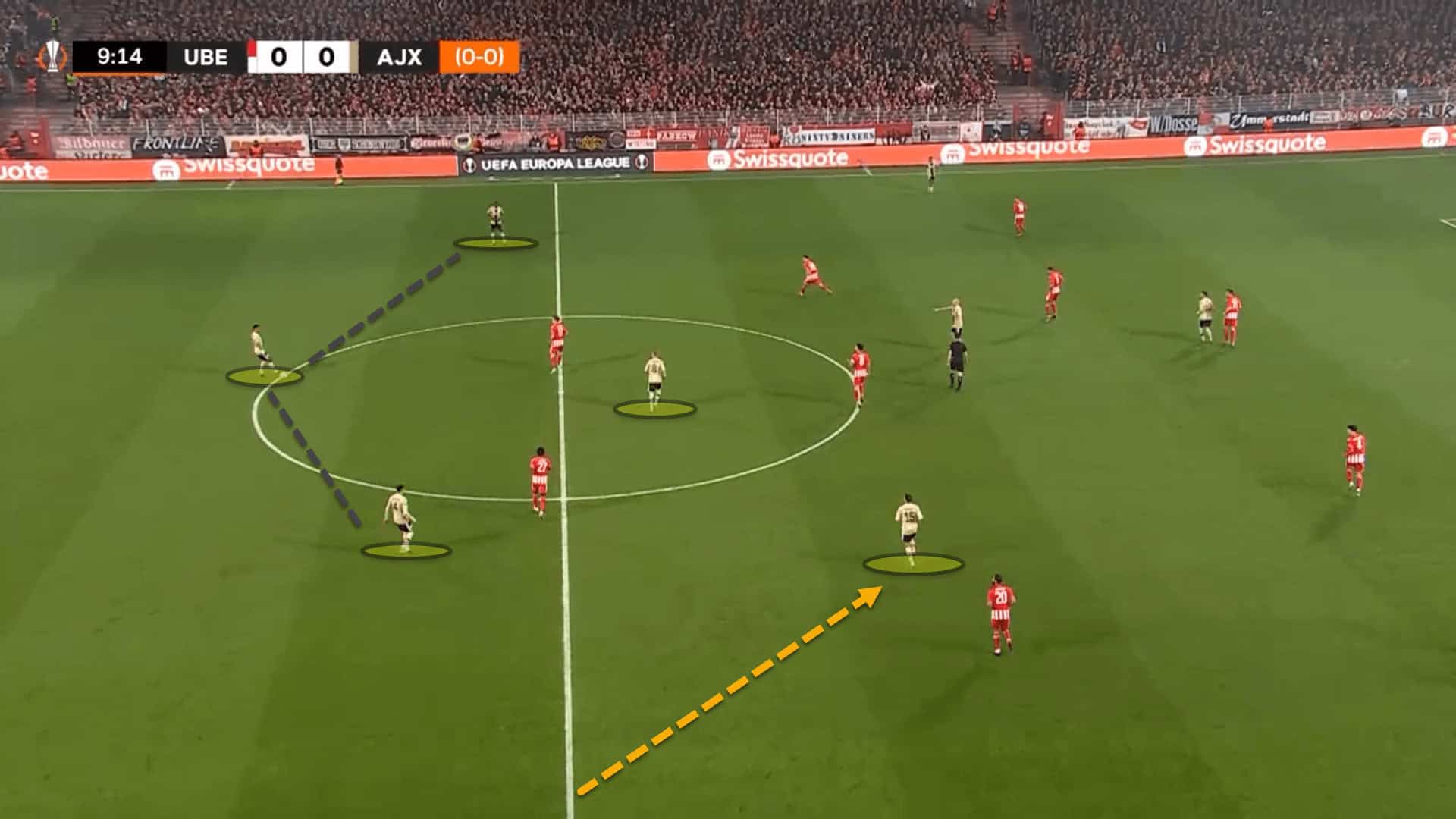
Here, Union Berlin are defending in a 5-3-2 with two strikers up top. As a result, Calvin Bassey, who was deployed as a left-back in that game, tucks inside to operate as a third centre-back alongside Edson Álvarez and Jurriën Timber to ensure that Ajax have a 3v2 against Union’s first line of pressure.
The fluidity of this set-up is one of the most interesting aspects of Ajax’s play and is something that has been a constant under ten Hag, Schreuder and now Heitinga.
Normally, when Ajax have three men in the first line, the head coach wants two players to operate behind the opposition’s strikers which creates passing lanes from all angles. But the order of this doesn’t really matter. Anyone can take up this role as the second midfielder beside the pivot player.
In the previous image, right-back Rensch inverted inside alongside Taylor, forming this 3-2 base but Ajax also have centre-backs who are really comfortable in higher areas such as Timber and Álvarez that are also able to push up into this space to try and receive the ball.
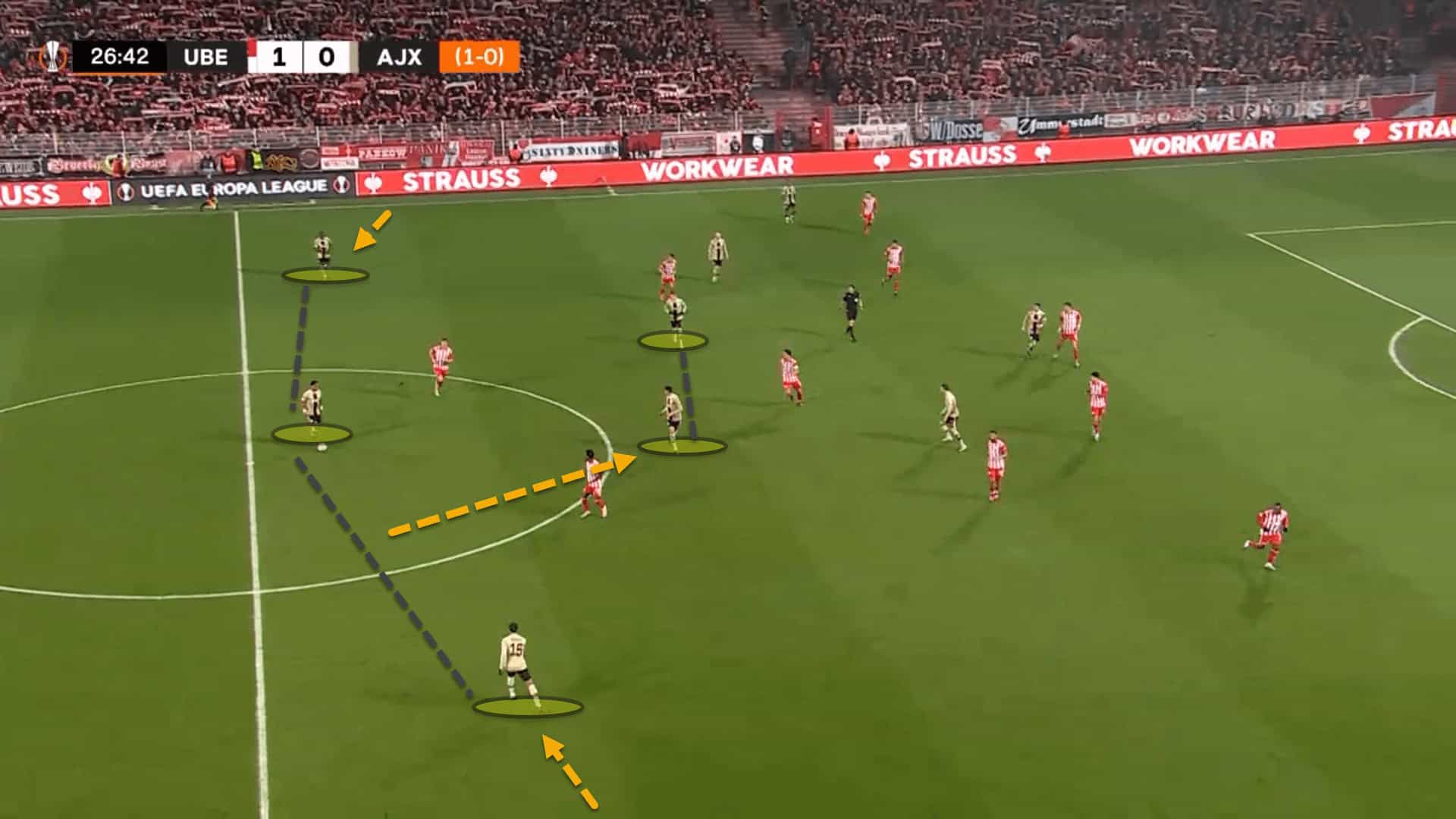
Look at this example. Despite his initial position being at centre-back, Álvarez has pushed up alongside Taylor to form a temporary double-pivot while the two fullbacks have tucked inside to create a back three with Timber. The shape is still a 3-2 but who plays where doesn’t really matter.
This is the very essence of evolved Total Football and is a joy to watch but has been a constant at Ajax under Heitinga’s last two predecessors also.
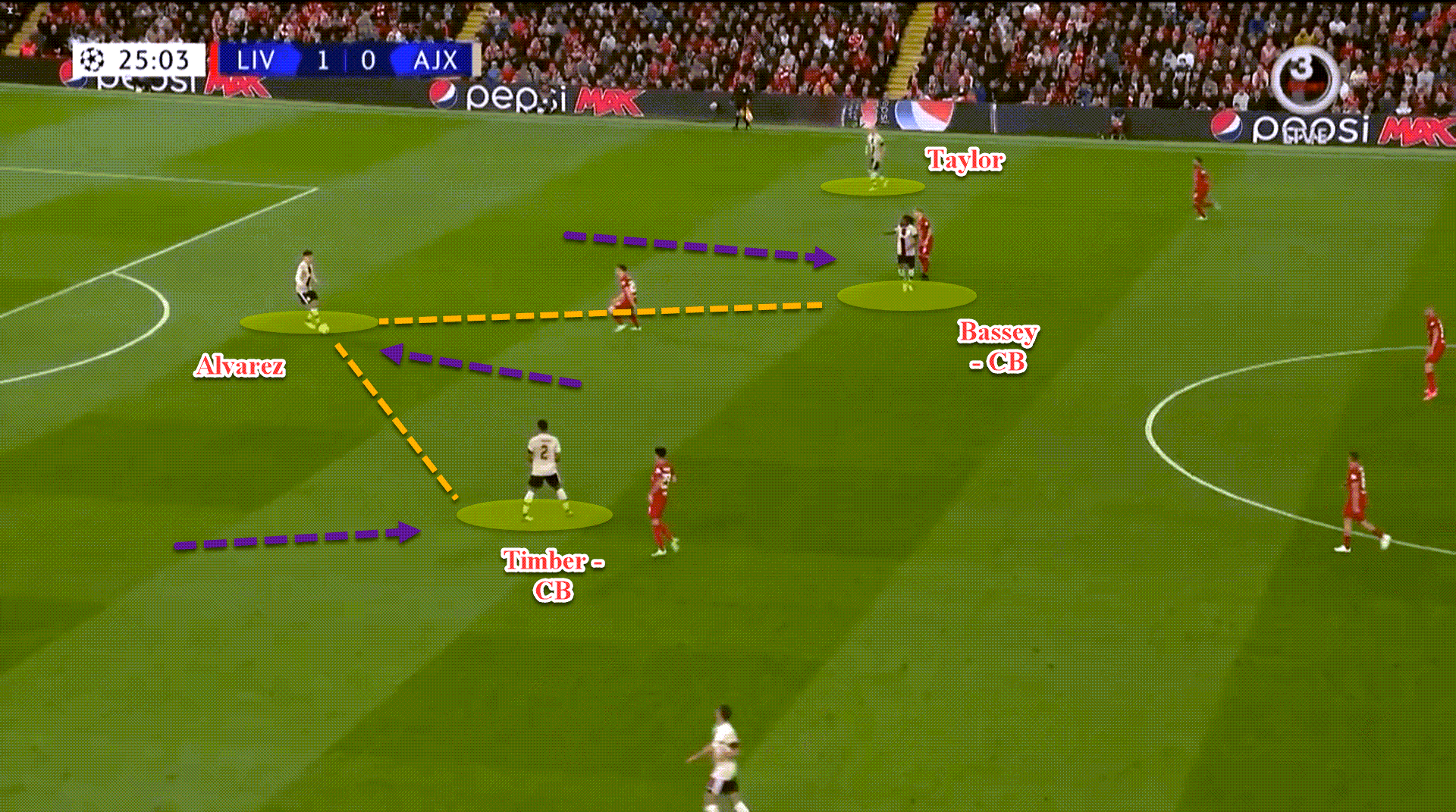
At Anfield earlier in the season, Ajax constantly pushed their centre-backs higher behind Liverpool’s first pressing line. In this game, Álvarez operated as the team’s number ‘6’, but in this situation, he was the deepest player as both Bassey and Timber moved into higher areas to try and receive to progress forward.
The objective of Ajax is to progress centrally through the opposition’s lines. This requires a high level of technical diligence but is certainly something the squad possesses.
Heitinga wants there to be several players between the lines of the opponent – three in particular. These three players are normally the two ‘8s’ and the centre-forward. Since Dušan Tadić plays as a false nine, he drops into these pockets.
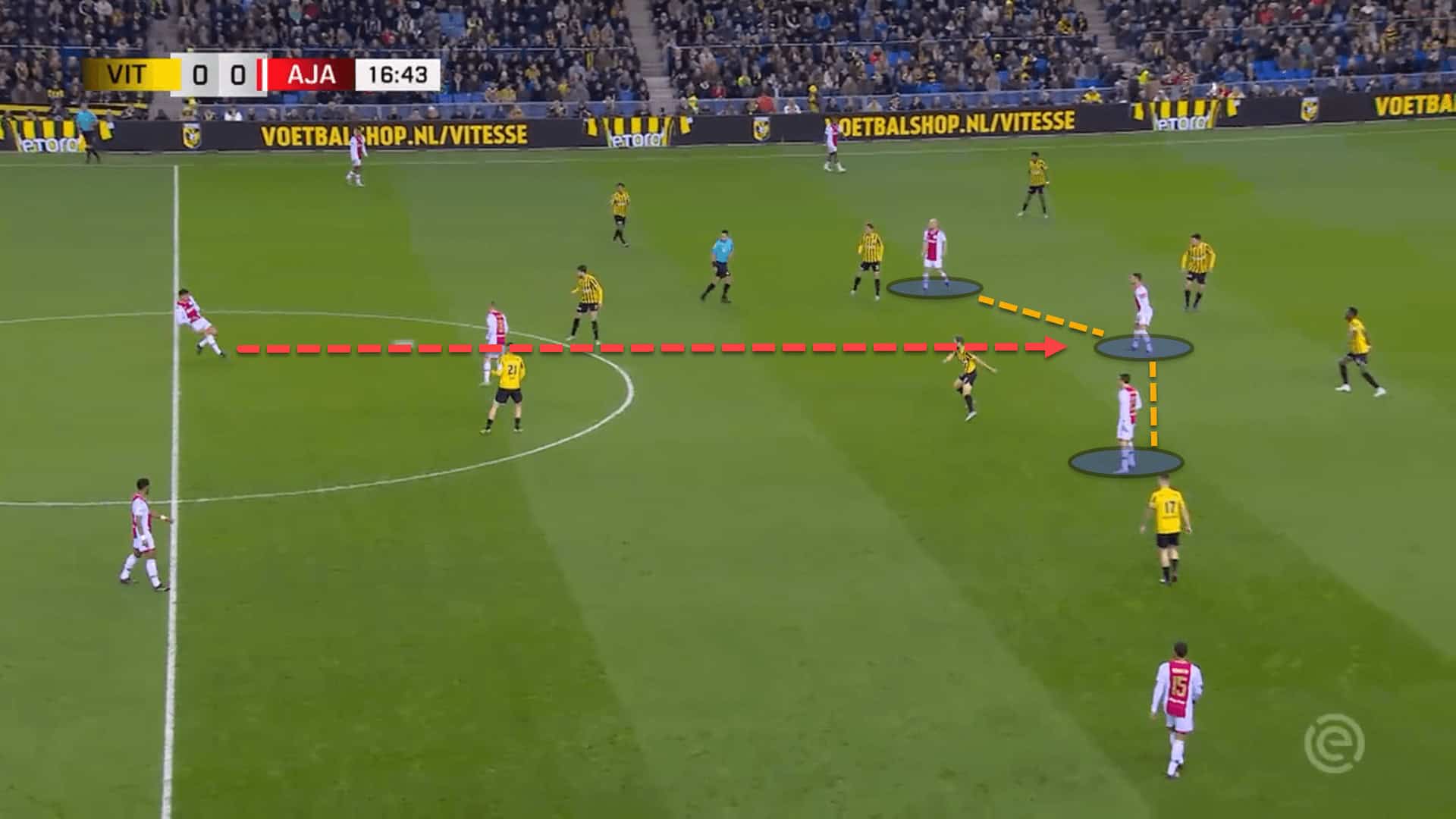
Davy Klaassen and Steven Berghuis, who started as the two advanced central midfielders in Ajax’s base 4-3-3, have pushed up between the lines alongside the false ‘9’ Tadić who has dropped deep into this area. Meanwhile, the two wingers are staying wide, stretching the pitch as well as the Vitesse defensive block.
Ajax’s forward line can be listed as a front five in this regard but there is no centre-forward occupying the opponent’s centre-backs.
Again, this is not a constant. Heitinga wants as many positional rotations as possible once the structure isn’t upset.
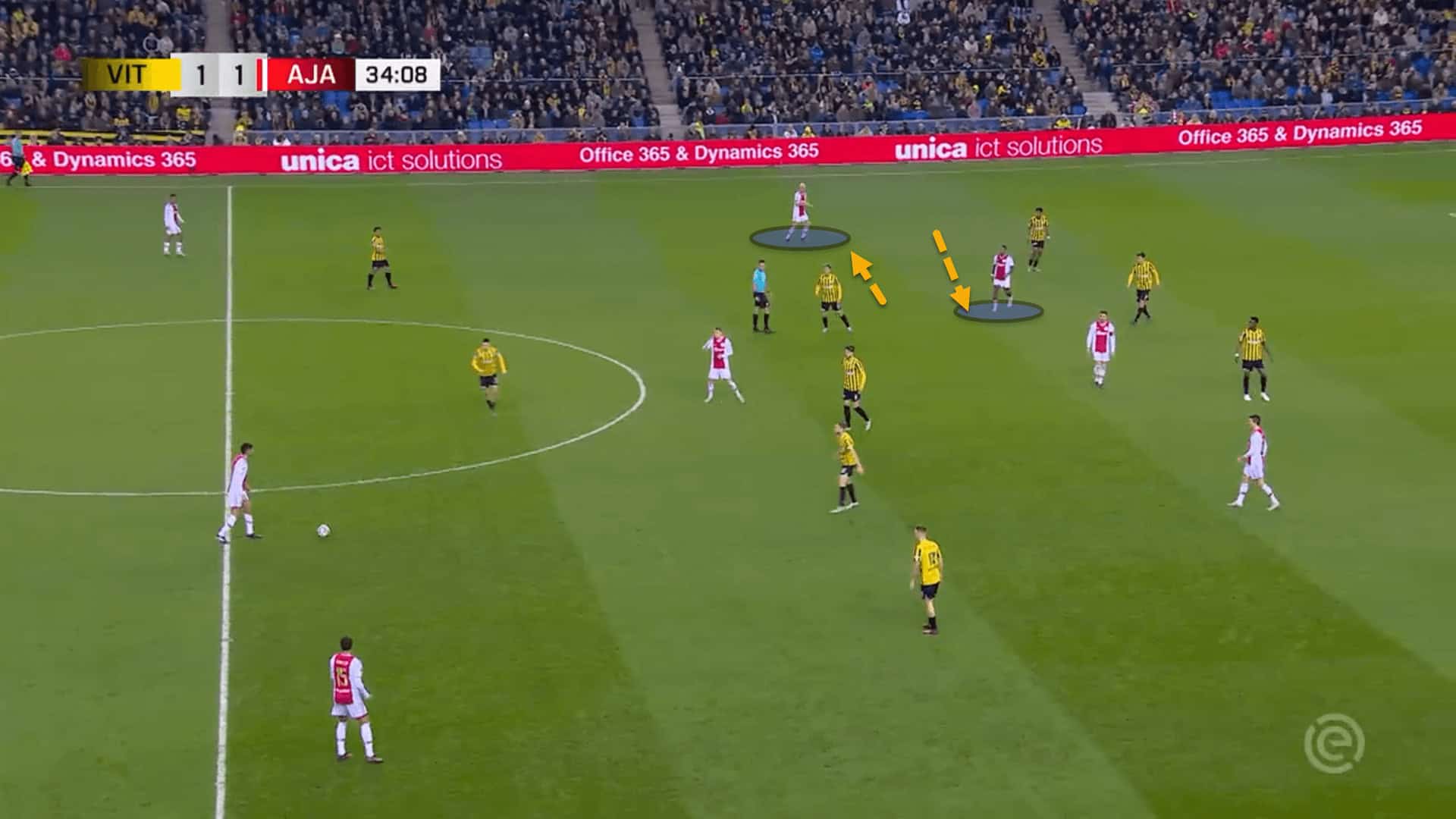
Here, Klaassen has become the left-winger with Steven Bergwijn pushing inside, taking up Klaassen’s position. The structure hasn’t been hurt, but the positioning of the players has changed. This offers an air of unpredictability about Ajax and discomfort to the opponent as they are constantly being tasked with defending against different players. This is just yet another example of Ajax’s modern Total Football rearing its beautiful head.
These three players between the lines can be labelled as triple ’10s’. In fact, Heitinga himself calls it this. Under ten Hag, having three ‘10s’ in these areas was very common and in an interview with The Athletic back in February 2020, Heitinga first made note of this tactical element:
“The system has changed if you see Ajax [under ten Hag], sometimes they play with three No 10s.”
The Eredivisie champions want to try and play to these three players but quite often, the defensive block is so compact that this becomes impossible. If they can play to the trio between the lines, then great, but if not, Ajax are fine with going wide to reach them.
The three players between the lines will make underlapping runs just inside the winger, looking to receive in behind.
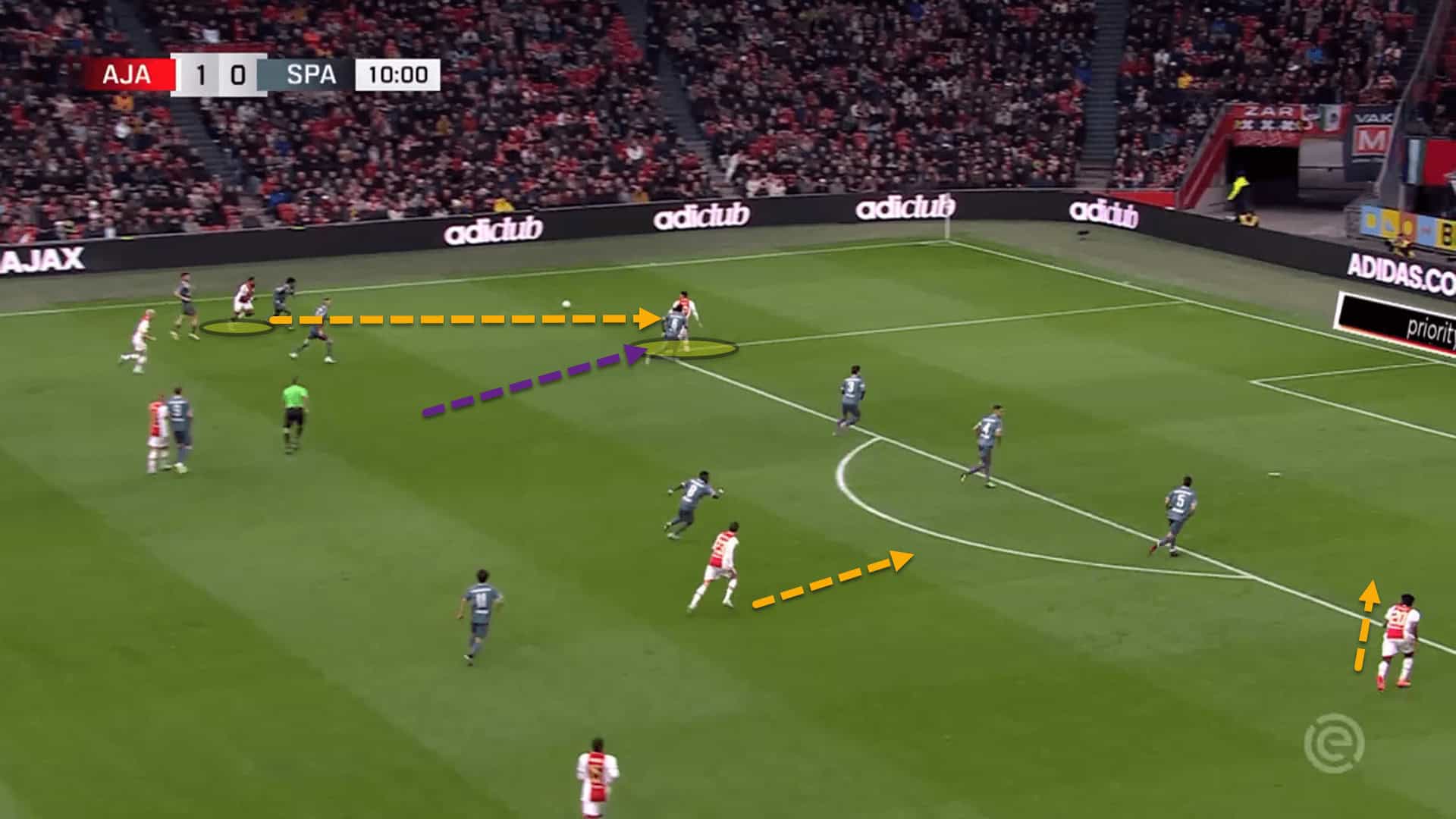
Here, Tadić is the one who has darted into the space behind the opponent’s backline, underlapping his left winger. From these positions, Ajax can play cut-back crosses into the box to be finished off by someone inside the penalty area.
Manchester City do this impeccably under Pep Guardiola and it has become one of the English champions’ primary methods of goalscoring.
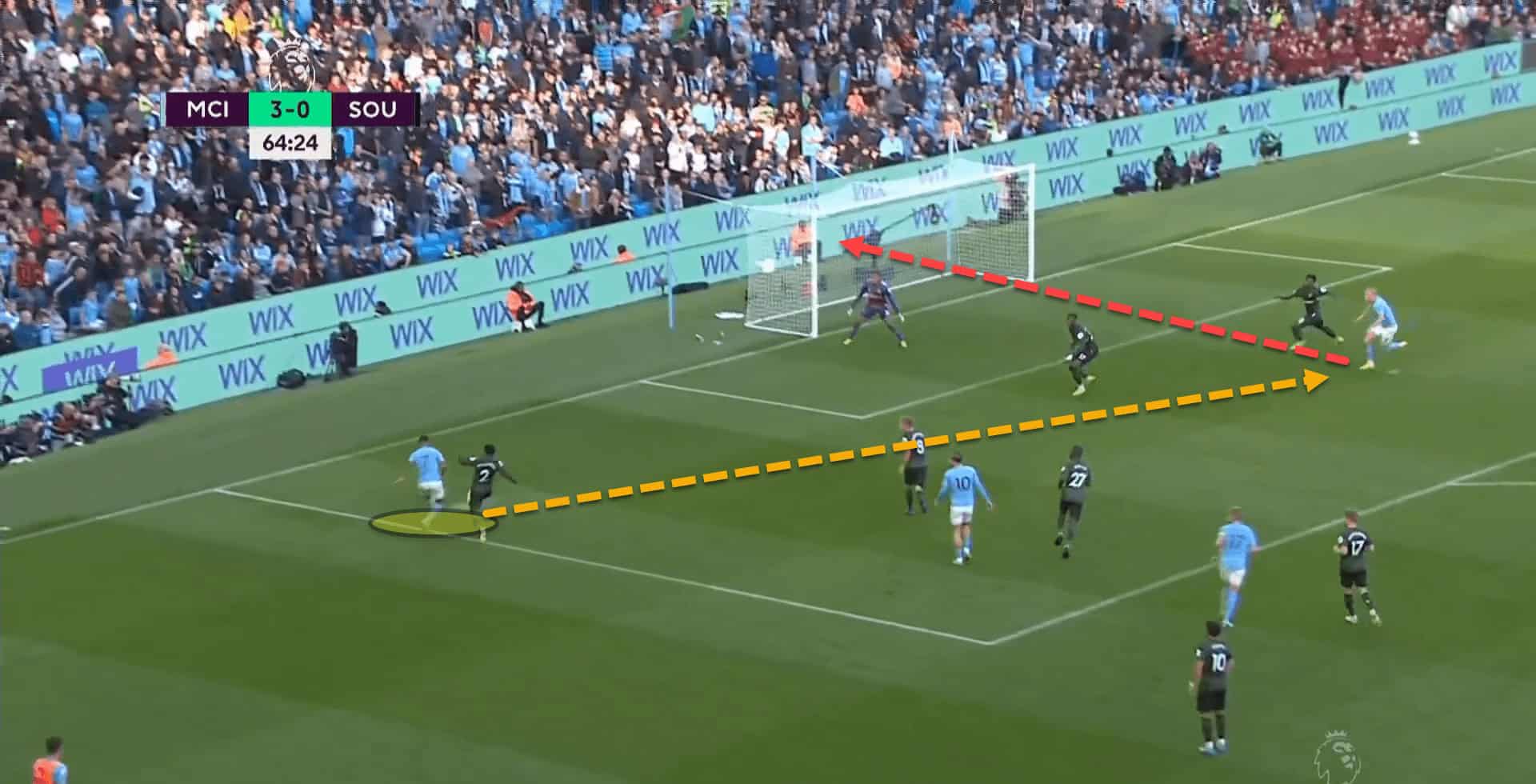
In this instance, Joao Cancelo received the ball in what has been called the cut-back zone and delivered a perfectly-weighted cross to the feet of Erling Haaland inside the penalty area. Of course, Haaland scored, making it 4-0 City against Southampton.
These cut-back crosses have been extremely useful for Ajax during Heitinga’s short-lived reign at the Johan Cruijff Arena.
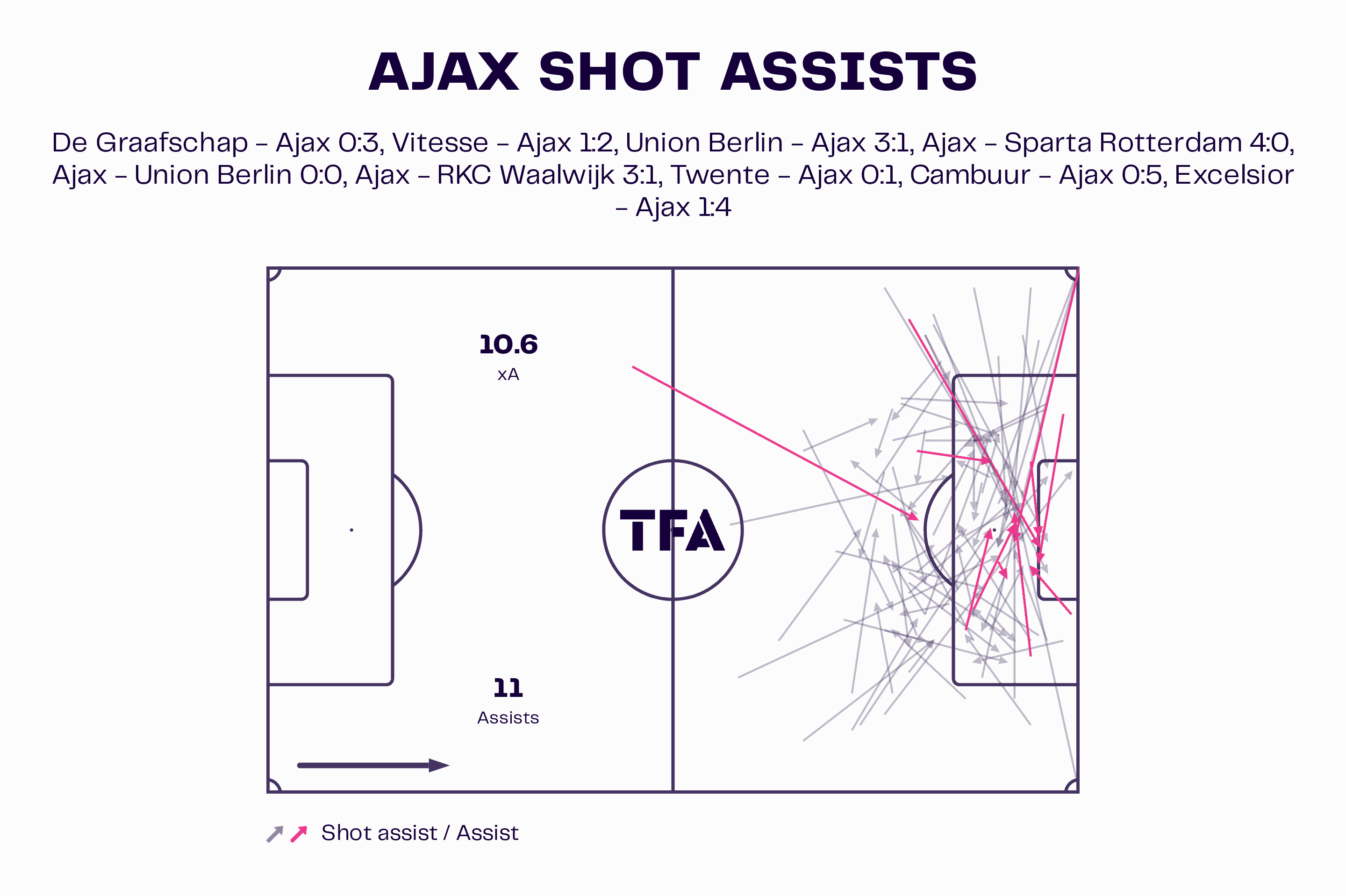
From the team’s shot assists map, we can see how many chances the Sons of the Gods have created from these halfspace areas, cutting the ball back into the box for a teammate to tap home.
Ultimately, it has helped Ajax to become far more potent in front of goal too. In Heitinga’s eight games in charge, the Dutch giants have bagged 21 times and are outperforming their xG of 16.96 despite not having an actual centre-forward on the pitch.
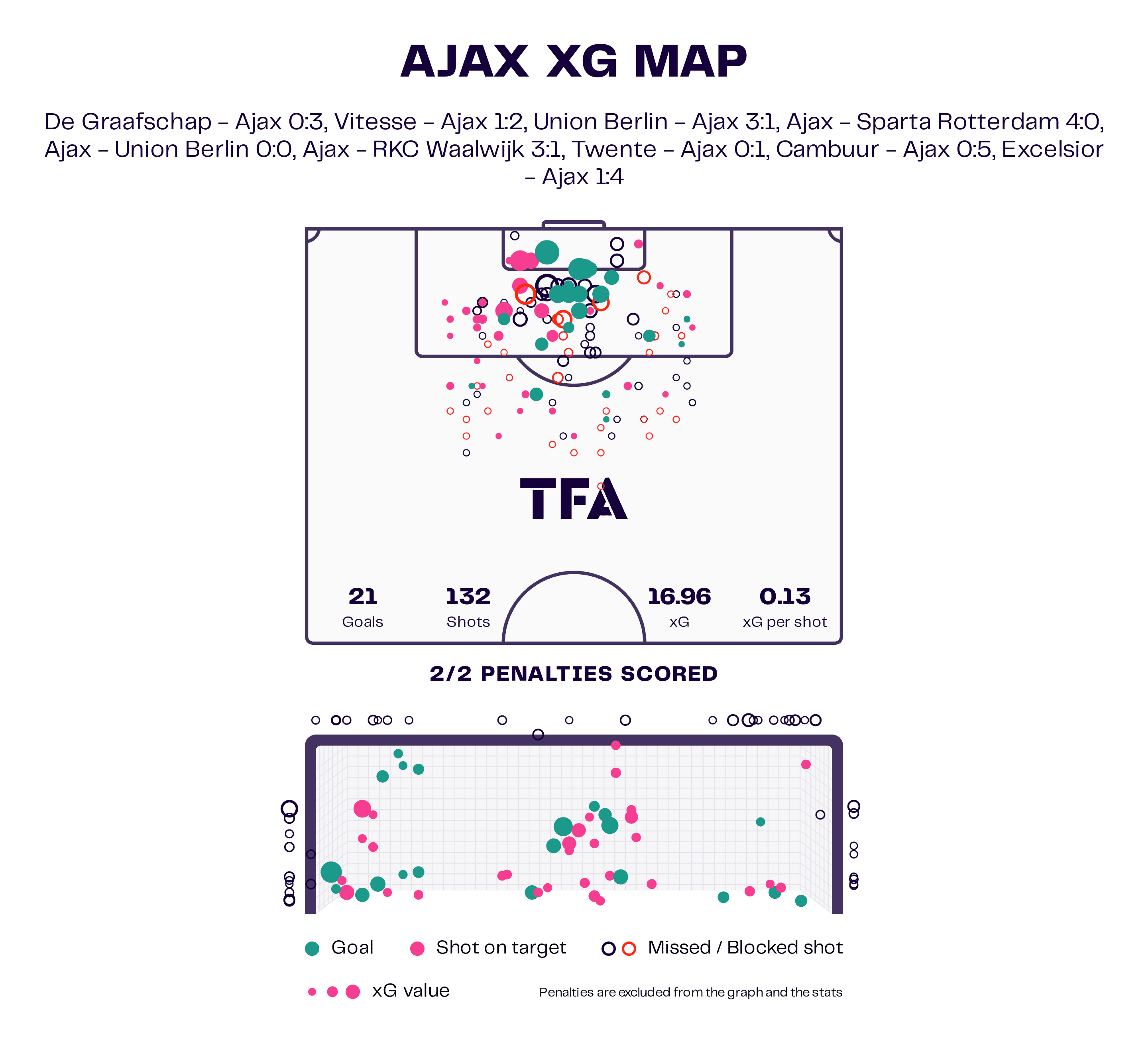
This is where Heitinga’s football differs from ten Hag. Where the Manchester United boss has always loved having a big man up top, whether it be Wout Weghorst at Old Trafford or Haller and Huntelaar at Ajax, Heitinga doesn’t really need a striker and the team are not suffering as a result.
In fact, having Tadić as the false ‘9’ has allowed the wide players to become heavily involved in the goalscoring as when the Serbian creator receives between the lines, the wingers dart in behind, looking to receive in space.
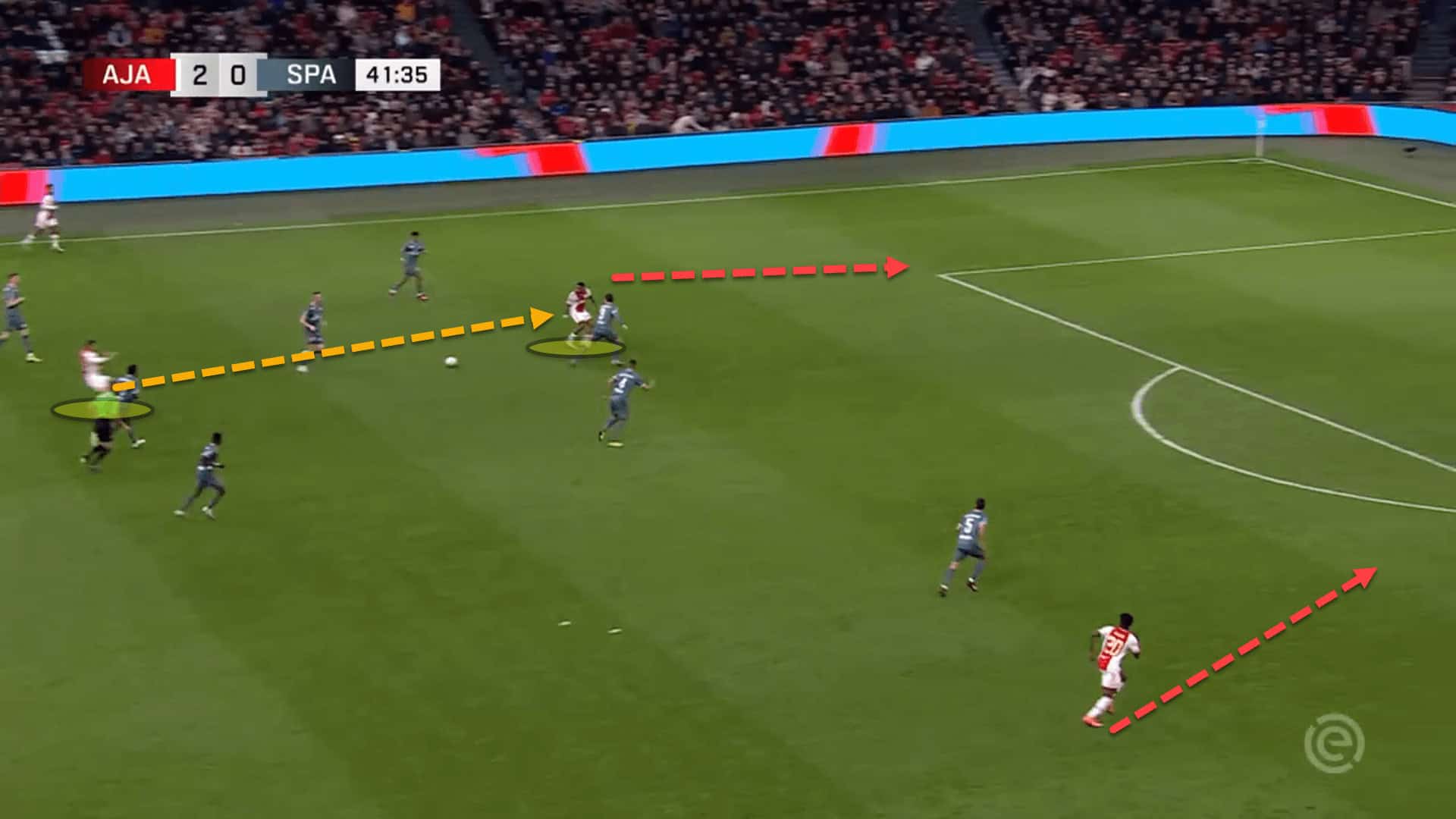
Tadić has dropped short to receive the ball and was able to turn quickly and face forward. Copping this, both wingers sprinted in behind, with Bergwijn receiving in the end. The weight of pass from the scintillating Serb meant the chance broke down but it could have ended in another excellent goalscoring opportunity for last season’s league winners.
When comparing Ajax’s xG map with Schreuder’s final eight games in charge, the difference is night and day. Ajax actually created more xG at 18.08 and had the same xG per shot value but were really struggling to tuck their chances away, converting just 13 of these opportunities.
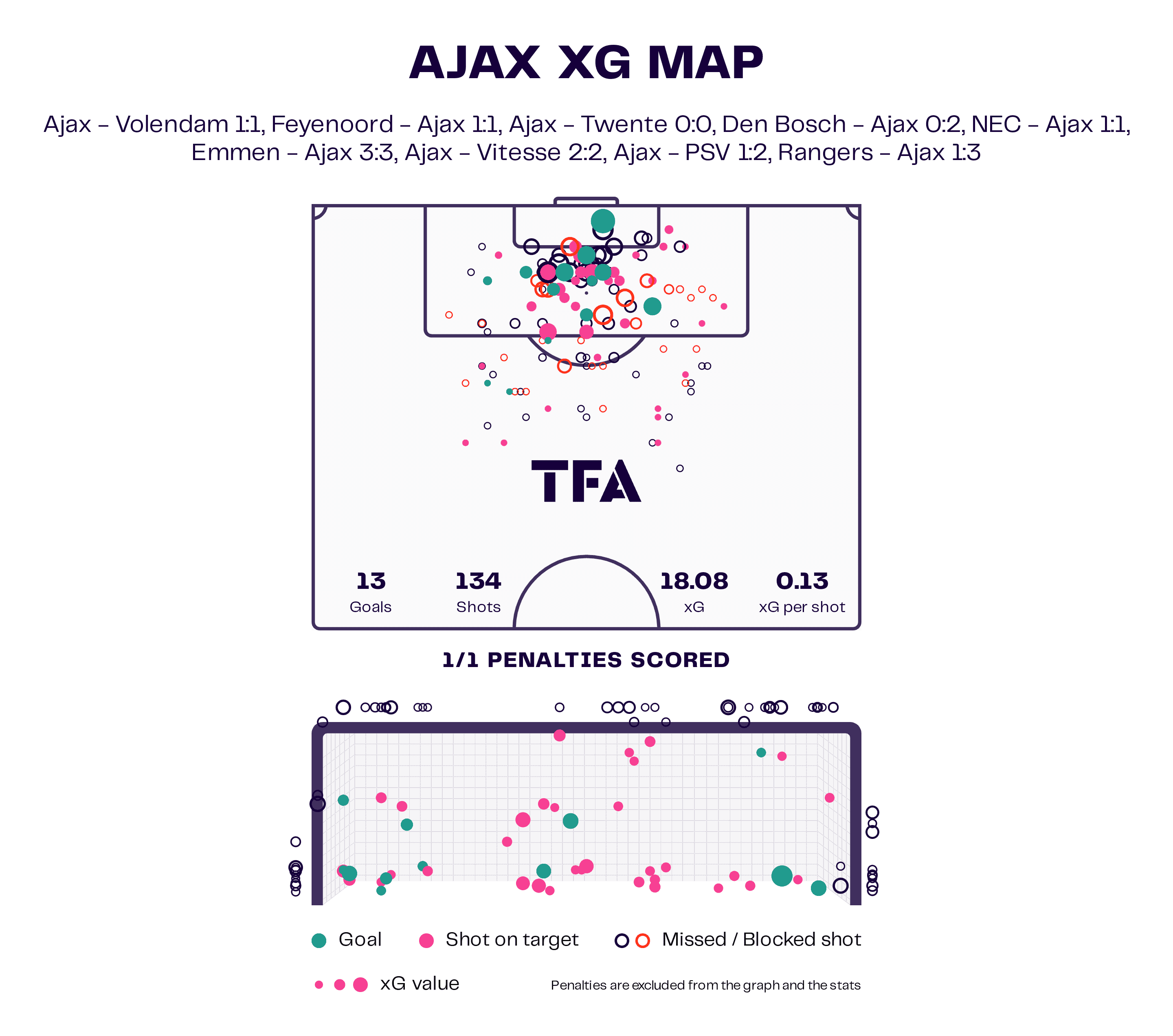
Ajax are more effective in possession under Heitinga than his predecessor and are far more dangerous in front of goal. Heitinga has managed to make Ajax look like Ajax again.
Strategy beats philosophy
In 2019, Ajax were just a few minutes away from their first Champions League final since Louis van Gaal’s reign in 1996 and were leading 3-2 on aggregate against Tottenham Hotspur. With the game locked at 2-2 in the second leg in Amsterdam, ten Hag’s men only needed to shut up shop.
But Mauricio Pochettino made one change in the away dugout that caused utter havoc. At half-time, Spurs were 2-0 down, losing 3-0 on aggregate and it looked like all hope was lost. Enter, Fernando Llorente.
Spurs stopped trying to match Ajax for beauty and began pumping it long to Llorente who is excellent in the air. Ajax couldn’t cope with the directness of the English club and in the 96th minute, a long ball up to the Spanish striker was headed down for Lucas Moura to snatch the winner, breaking the hearts of everyone in Amsterdam.
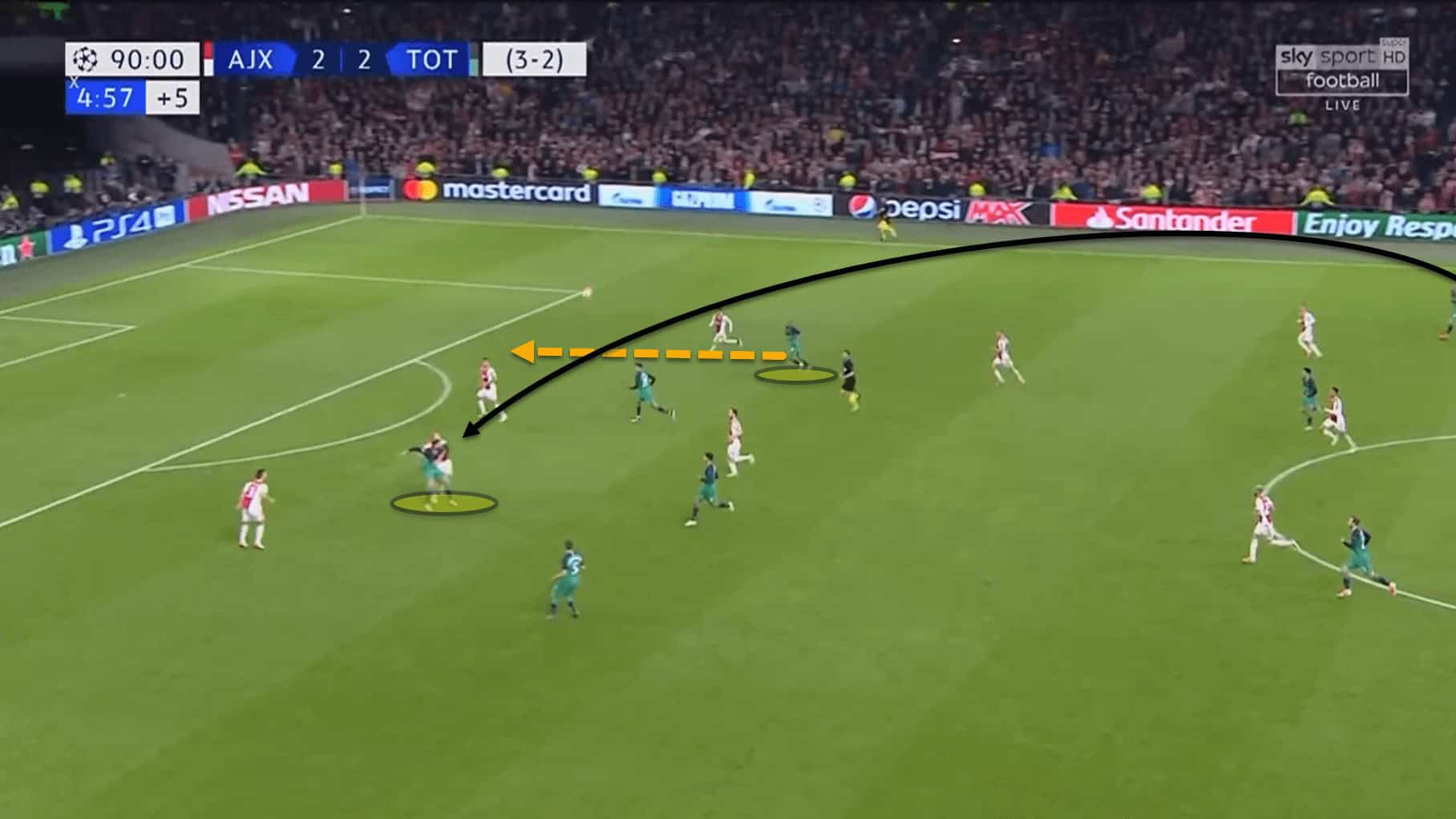
After the game, while on the punditry panel for biEN Sports during his sabbatical from football, legendary coach José Mourinho summed up Ajax’s struggles perfectly:
“We thought that Ajax achieved a certain level of maturity, and they didn’t. They showed in the second half that there is still naivety in that team, and I think the philosophy lost against the strategy.
“The philosophy brought Ajax to this position of playing fantastically well and arriving with one and a half feet into the final but then, the strategy won.
“Blind couldn’t cope with Llorente. The defensive line couldn’t cope with the long ball. Llorente’s chest was the link for everything, and strategy beat philosophy.”
And José would know better than anyone. In 2017, he lifted the Europa League crown, having guided Man United to a comfortable 2-0 victory over Ajax, using Marouane Fellaini as a number ’10’, causing a highly inexperienced and young backline a mountain of problems in the air.
When analysing Ajax under the new head coach, it became clear that the team have been facing the same problem for a significant number of years. The issues that caused them to throw away a three-goal lead in a European semi-final are still prevalent to the present day, particularly when playing against a team who are not afraid to lump it long.
The most recent case study of this was against Union Berlin in the UEFA Europa League. Having tied the first game, Ajax were put the sword 3-1 by the German underdogs.
Urs Fischer’s team are notoriously direct anyway but playing long to the two strikers caused all sorts of issues for Ajax.
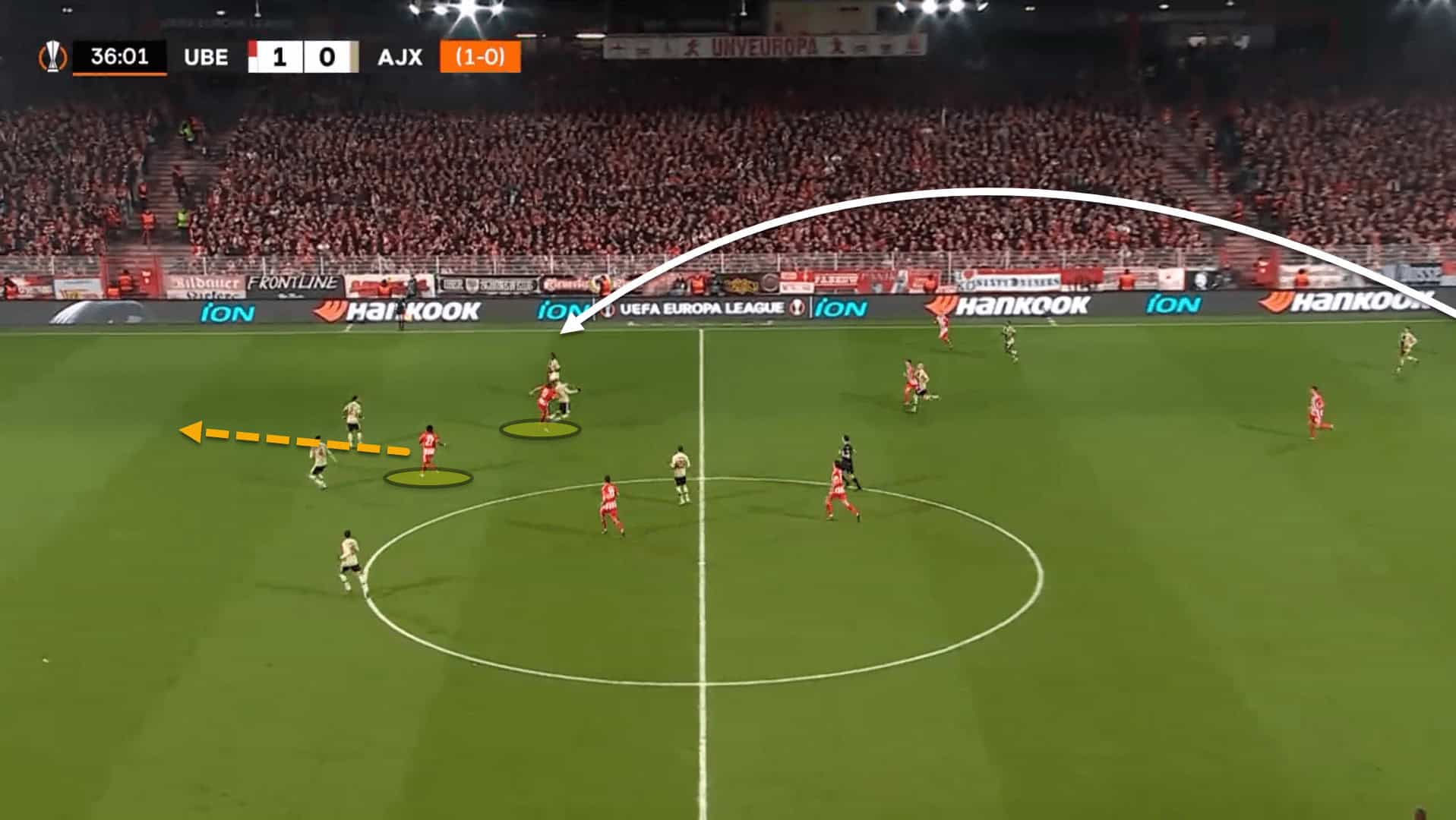
Here, Union were pressed high by Ajax in a mix of a zonal-man-oriented hybrid. Ajax use the striker to force the opposition to one side and then lock on in the wide areas, going man-for-man.
Union were not risking trying to play out and so hit it long towards the centre-forwards from the backline. One challenged for the ball to flick it on and the other ran in behind.
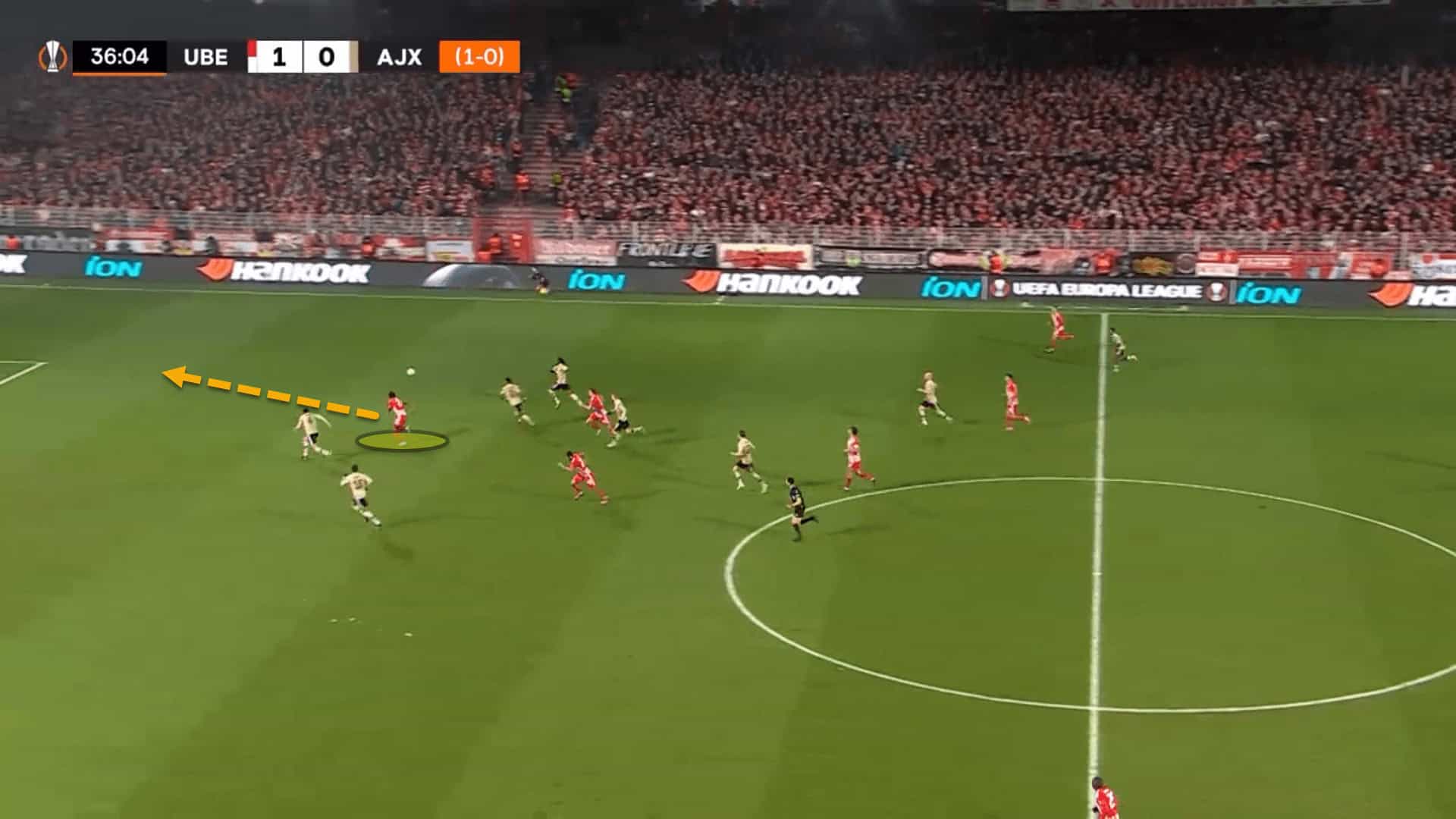
It was a simple move but was an easy method for the Bundesliga club to reach the final third in just three touches of the ball and the long ball led to a decent chance for the home side en route to their progression to the next round of the competition.
Ajax play like a poet and write some of the most beautiful material you can read. Unfortunately, as has been a theme for a number of years, even a well-crafted poem can look shaggy on a coarse canvas.
Conclusion
Whether Heitinga will be a success at Ajax is yet to be seen but already, he has captured the hearts of the supporters who grew rowdy and tiresome during Schreuder’s dire reign at the helm.
They are still quite a way off being the team that reached unthinkable heights under Erik ten Hag but are at least back in the conversation for the title, sitting third and just three points adrift of league-leaders Feyenoord, coming back from fifth place and seven points off last season’s UEFA Europa Conference League finalists after Schreuder was dismissed at the end of January.
Heitinga’s contract only runs until the end of the current campaign but van der Sar and co. could certainly extend that deal should the club legend can lift the league title by May.






Comments